The kitchen sink tends to be a focal point in most kitchen designs. You may not even realize how much time you spend at the sink, from washing hands to prepping food to cleaning dishes and pots. Some large kitchens even have more than one sink, each with a dedicated purpose or to allow more than one person to work in the kitchen simultaneously. You may even have a wet bar in your kitchen, with a sink dedicated to preparing drinks for guests. Such a busy spot in your kitchen deserves a sink and faucet pair that stand up to your functional requirements and look good at the same time.
Our guide to everything you need to know about sinks and faucets will help you find the perfect pair to elevate your kitchen!
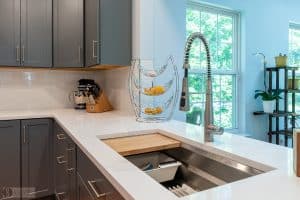
First, determine your key requirements.
When remodeling your kitchen, it is crucial to start by understanding your home’s unique requirements. Your family’s needs will differ from others so you should always create your design to fit your home and not to precisely match the glamorous kitchens you see posted on social media. Once you know your preferred design style and have decided on a layout, it’s time to select products to bring your design to life. With a wide range of options available at different price points, it is helpful to narrow down your choices first based on your functional needs.
Assess your current kitchen design and determine what you like and dislike about it. For instance, you might love the position of your kitchen sink since it lets you look out the window at a favorite view, but you desire an updated style and improved functionality with a new faucet. Alternatively, you might consider relocating the sink to an island to facilitate dinner preparation while keeping an eye on the kids. Jot down your ideas and bring them, along with photos of your existing space and your design inspirations, to your meeting with a kitchen designer.
Consider your family dynamics and lifestyle when planning all aspects of your kitchen design, including the sink and faucet. Who typically uses the kitchen and will this change very much over the lifetime of the kitchen design. Are you creating your design for a young, growing family? Or are you designing for your own needs and for aging in place? Create a design that suits your individual needs, whether that is accommodating little hands in family baking projects or helping an older family member to be independent and cook for themselves.
If your kitchen is busy with multiple individuals or various activities happening at once, you might want to consider a large, deep sink with two faucets or even two separate sinks for different purposes. If you have a butler’s pantry, you could include a sink in this space dedicated to food prep or clean up. Do you also frequently entertain guests or host family holiday gatherings? If so, a dedicated beverage bar with a separate sink might be worth considering. A design tailored to your family’s needs will enhance your quality of life for years to come.
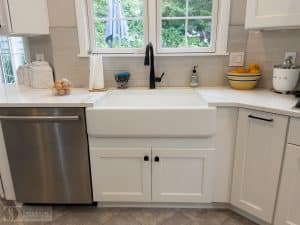
Then, consider what you want from your sink and faucet.
Every element of your kitchen design works together to create a functional and stylish space, and the sink and faucet are no exception! You may think of these fixtures as being purely utilitarian, but they actually work together with surrounding elements to enhance your room’s design aesthetic. The sink is typically positioned in a central location in the kitchen and therefore stands out. Thankfully, they come in a range of styles, materials, and finishes that make them a design asset in your kitchen.
Choose a sink that fits your style, from traditional to modern, in a material and finish that blends well with your other design features. Alternatively, you can select a sink material that stands out on its own and make the sink a design focal point. You can select a faucet that matches the sink, or another finish that fits in with other features like your cabinet hardware or light fixtures. Many faucet designs have a high arc, making them a prominent feature and a prime opportunity to draw attention.
There are so many choices for sinks and faucets, which can make this decision feel overwhelming. It helps to browse your favorite social media design pages or websites to get inspiration. Then discuss the options with your kitchen design professional, who can bring their product knowledge and design expertise to the table to help you identify the ideal options for your home.
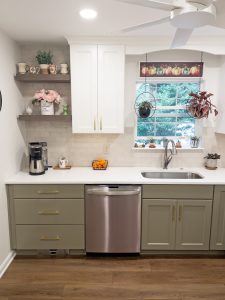
Now, let’s explore the choices for kitchen sinks.
With so many options available, there are sink styles, finishes, and budget ranges to suit every kitchen design. Let’s start by exploring the different types of sinks and the range of materials and finishes available.
Sink Types
Undermount sinks are the most popular choice for today’s kitchen designs since they provide a neat profile and allow for easier clean up. They require more skill to install, as they must be matched to a hole cut into the countertop and then attached by clips. This is a job best left to the experts and not one for the do-it-yourselfer. Since the sink fits neatly under the countertop, water and other liquids can be swept easily into the sink.
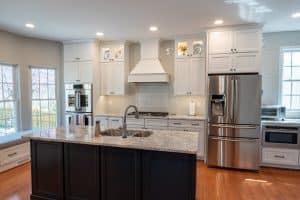
Top mount or drop-in sinks, on the other hand, are easier to install as they have a rim that fits around the hole in the countertop. They tend to be less expensive and, since they are better suited to a DIY installation, can be a more budget-friendly option. Drop-in sinks can be found in a range of materials and finishes to fit different styles. The rim that sits around the countertop means they don’t look as sleek and are not as easy to keep clean.
Farmhouse sinks are a functional and stylish option, and it’s important to note that this style is not just for farmhouse kitchens! This sink type is installed just below the countertop level with the front exposed, and often it sticks out just past the countertop. They are known for being large, deep sinks so they can hold big pots and pans from large family dinners or batch cooking. Traditionally seen in white, the latest farmhouse style sinks can be seen in stainless steel, as well as stone, composite, and copper.
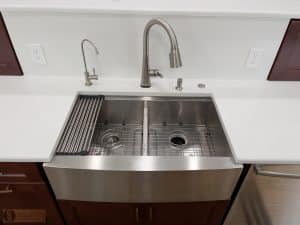
There are a few other options that distinguish one sink from the other, including:
- Single bowl sinks have one large basin, which is ideal for accommodating large pots and dishes.
- Double bowl enables more than one task to happen simultaneously in the sink, with, for example, one side reserved for washing vegetables and the other for rinsing dishes.
- Low-divide double bowl gives the benefit of a double bowl but with a neater, low profile as the divider sits lower in the bowl.
- Workstation sinks turn your kitchen sink into a multi-functional tool with accessories that make it easier to shift from food prep to clean up.
Sink Materials and Finishes
There are many materials and finishes available for kitchen sinks, which influence its style, weight, durability, price, and more. Stainless steel is one of the most popular and common materials, but many other options are also available depending on your needs.
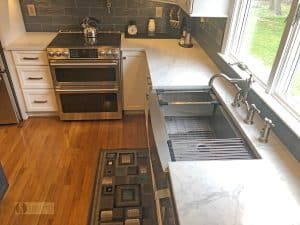
- Stainless steel is popular and it’s easy to see why. It’s a relatively reasonably priced alternative depending on the model you choose, and it also tends to be easier to install than other options. Stainless goes with literally any style kitchen remodel, and its versatility extends to undermount, drop-in, and farmhouse sinks.
- Granite composite sinks have grown in popularity, as they are not only stylish, but also durable and hygienic. This nonporous material is scratch- and heat-resistant, making it as easy to maintain as it is stylish.
- Cast iron sinks are a more expensive option, but the higher price tag brings a heavy and durable material. This also means that they must be professionally installed, as they are too heavy for a DIY installation. They are typically finished with a glossy white enamel coating, which gives any farmhouse or cottage design a classic look.
- Fireclay sinks are made of clay and glaze that is fused at a very high temperature. They appear similar to cast iron, but they are more durable and also more expensive.
- An integrated sink is made of the same material as the countertop, usually from one continuous piece of the material. The benefit of this option is that it provides a sleek style and really simplifies clean up since there are no gaps or lips between the sink and countertop to work around. The downside is that if either the sink or countertop is damaged, you often have to replace both.
Now let’s look at the options for kitchen faucets.
At their most basic level, faucets are there to deliver hot and cold water on demand to key locations in your home, such as the kitchen and bathrooms. However, not all faucets are alike! They can differ based on the type, mounting method, material, and finish, and each comes with its own benefits and cost.
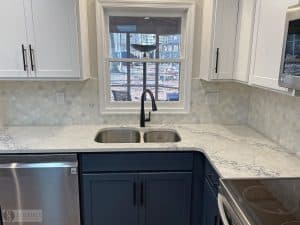
Faucet Types
There is a wide array of kitchen faucets to suit all styles and budget ranges. There are even some with high tech features that can be touch or voice-activated, or that can serve up carbonated or boiling water on demand! Here are some of the top choices for faucet types:
- Pull down faucets have a spray wand that pulls down into the sink.
- Pull out faucets allow you to pull the faucet head straight out and provide a greater range to assist in clean up.
- Touch-free faucets have sensors that let you turn the faucet on or off with wave of the hand.
- Smart faucets use high tech features that allow you to control the water pressure, temperature, and other presets with voice, sensor, or app controls.
- Commercial models have a high arc, with a more flexible spout that helps in preparing food and cleaning up.
Faucets also come with different neck types, including curved, straight, or high arc neck. They can also be found in two-handled or single-handled models. The other distinguishing factor is the mounting option, which affects the faucet’s position, installation method, and number of holes required. Deck mount faucets are one of the most common types, with wall mount faucets being more popular for bathroom designs.
Faucet Materials and Finishes
Your kitchen faucet is more than meets the eye. Inside the faucet are components that affect the durability, ongoing maintenance, and the price tag, so be sure to ask about the inner workings of your preferred faucet options to see which is right for you.

The outside of the faucet has a finish applied to it, which influences the faucet’s style but also is ongoing maintenance needs. These include:
- Polished chrome is always a popular choice, with a silver finish that gives your kitchen design a shine. Be aware this finish can be prone to water spots and needs to be wiped down regularly.
- Polished nickel is similar and suits traditional style kitchens well.
- Stainless is a popular choice that gives any kitchen design a cohesive look when paired with stainless steel sinks and appliances.
- Matte black is a top option that pairs especially well with light-toned kitchens and can be part of a mixed metal style or matched with matte black cabinet hardware and light fixtures.
- Brushed or satin brass has a muted gold appearance and works with a wide range of color schemes, but really offsets blue or black cabinetry, and will make any sink a design focal point.
- Oil rubbed bronze is a deeper shade that works well for a more traditional kitchen style.
Now we can find your ideal sink and faucet pairing!
With so many options, how can you find the perfect pairing of sink and faucet for your new kitchen design? Look first at your functional needs and find the right choice that fits your family and home.
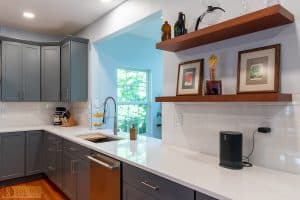
Choose a model that is accessible to all users of your kitchen, for example touchless or single handled faucets are easier for older family members to use than two handled faucets. Next, consider if you will have more than one sink, what their purposes will be, and which sink and faucet styles best fit those needs. For example, a beverage bar sink may be smaller with a smaller faucet. Also consider the clearance available for the faucet installation, especially if it is going to be installed under wall cabinets.
Next consider your preferred style and how it fits into your overall kitchen design aesthetic. Are you going for a cohesive style, where you want your sink and faucet to blend with the same style and finish? Or do you prefer the current mixed metal trend, where you pair two metal finishes to give your design a more eclectic vibe?
Last, look at your budget and determine how much you can spend on your sink and faucet options. Like with so many design items, you get what you pay for, so spending more on quality materials will be more durable and last longer. If, however, your budget is more limited, there are a wide range of alternative options to fit your budget and meet your needs.
You spend so much time at the kitchen sink: preparing vegetables, washing hands, rinsing the kids’ art supplies, washing pots and pans, filling water bottles and glasses, and much more. Choose a sink and faucet combination that will not only meet the demands of your busy household, but also look amazing and complement your kitchen’s design aesthetic. We can help with all your kitchen remodeling needs, so contact our team to start planning your ideal kitchen today!
